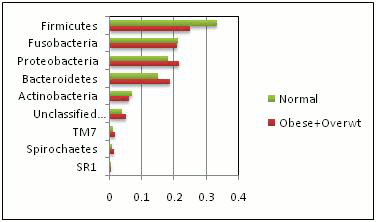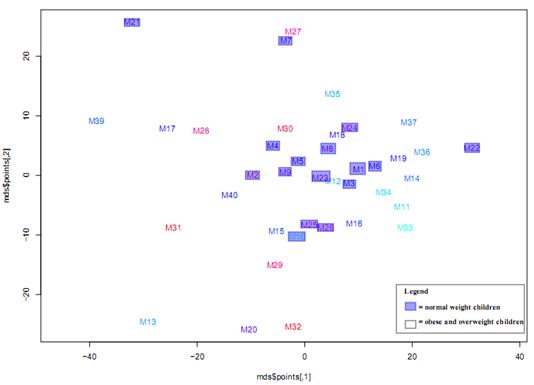Background: Obesity has been associated with an increased risk of periodontal diseases. Elucidating the association between the two conditions is critical for establishing how oral health may influence overall health.
Objective: To compare the microbial composition of oral biofilms in children of different body mass indices (BMI).
Methods: Forty supragingival and subgingival plaque samples were collected from obese and healthy children. These subjects were measured for their BMI, gingival bleeding on probing, and concentration of tumour necrosis factor (TNF) in their gingival crevicular fluid. Bacterial diversity in the plaque samples was assessed by sequencing and analysis of the V1-V3 region of 16S rRNA by 454-Titanium.
Results: Over 90% of the sequences from the normal and obese groups belonged to five bacterial phyla: Firmicutes, Fusobacteria, Proteobacteria, Bacteroidetes, and Actinobacteria. However, an assessment for differential abundance in the two groups identified several interesting taxonomic groups that showed statistically significant differences in their abundances (p<0.05). They include Firmicutes and Spirochaetes at the phylum level (Figure-1), as well as Streptococcus and Treponema at the genus level (Figure-2). In multidimensional scaling (MDS) scatter plots, results for the normal group appeared to cluster while those of the obese group widely dispersed, indicating a relatively more stable bacterial population in the normal group (Figure-3).
Conclusion: The data indicates a significant difference between the bacterial composition of oral biofilm in obese versus normal weight children. The microbiota associated with children of normal weight exhibited a more stable composition compared to that of obese children. Fluctuations in bacterial composition in the obese children may result from or facilitate the development of obesity.
Figure-1. Phylum distribution in the two groups of samples.
Keywords: Bacterial, Biofilm, Children, Metagenomics and Periodontal disease
![[ Visit AADR's Website ]](images/banner.jpg)


